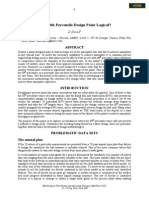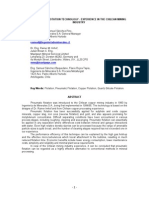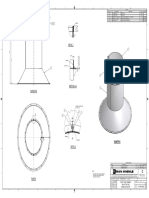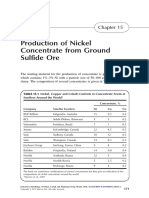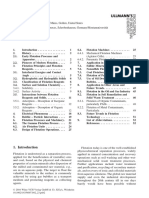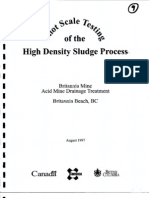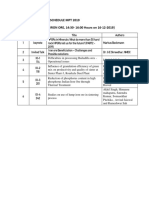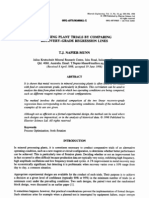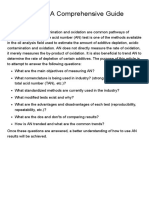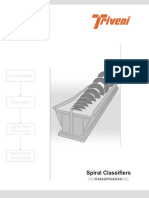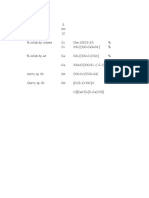Coal Flotation-Technical Review
Coal Flotation-Technical Review
Uploaded by
rajeevup2004Copyright:
Available Formats
Coal Flotation-Technical Review
Coal Flotation-Technical Review
Uploaded by
rajeevup2004Original Title
Copyright
Available Formats
Share this document
Did you find this document useful?
Is this content inappropriate?
Copyright:
Available Formats
Coal Flotation-Technical Review
Coal Flotation-Technical Review
Uploaded by
rajeevup2004Copyright:
Available Formats
Coal Preparation
Coal Flotation
Technical Review
A Report on an ACARP Project undertaken by Mike Williamson and Joe Sanders
Nicola Heiser
The Australian Coal Background has led to the development of several
new flotation machines. Three types are
The ACARP study on f lotation tech-
Association Research Program niques was undertaken by Mike
commercially available in Australia and
will be discussed in detail further on.
(ACARP) recently Williamson and Joe Sanders, both of New processes, still in the R&D stage
whom have extensive experience in are:
commissioned a study into the the Australian and overseas coal indus- ■ Packed column
tries. It involved a survey of published ■ Advanced Fuel Technologies (AFT)
status of flotation in coal information and inter views with Cell
researchers, equipment suppliers and ■ Flotaire Column
preparation, in order to direct plant operators, supplemented by ■ Centrifloat
site visits. The intention was to relate the ■ Tower Flotation
limited funds to areas of study to industry needs and operational ■ Cyclof lotation (Reviewer's note:
requirements, and to this end, perfor- Australian work in this area is carried
maximum benefit. The primary mance information was obtained from out under the term 'Turboflotation’.)
full-scale operations where available. The commercially available new
purpose of the study was the This report summarises the concepts and processes can be divided into two cate-
conclusions that were presented in the gories: true column flotation, as repre-
assessment of new flotation original comprehensive review.
sented by the Microcel, and shallow
technologies, including those Status of Flotation column/flash flotation (the Jameson cell
and Ekof cell). A fundamental difference
commercially available and Spirals and water-washing spirals may of the new processes is the generation
compete with conventional flotation of fine bubble sizes, and has led to the
those still under development. for processing the coarser ends of the use of the term ‘microbubble flotation' to
fines beneficiation requirement, but poor describe the technology. The smaller
selectivity of finer sizes of all gravity- bubble size gives a higher surface area for
based processes, and the difficulty in attachment, and more bubbles to
excluding 'slimes' from the product, increase the probability of bubble-
make the availability of effective coal particle collision than for the same
flotation a desirable target for industry. volume of air in conventional cells.
Perceived problems with conventional
cells are: Jameson Cell
■ highly varied design, with unclear
advantages for each, Mount lsa Mines developed an interest
■ poor air control, as observed from in Jameson cell technology after a
periodic extreme cell disturbance, growing dissatisfaction with convention-
■ unpredictable scale-up performance, al metalliferous column f lotation.
■ requires continual operator/metallur- The concerns with the columns were
gist attention, the costly maintenance of sparging sys-
■ becomes adversely affected as wear tems, the gradual fall in performance
progresses (the impellers in particu- as the spargers wore, the cost of the
lar are susceptible to high wear rates), air supply, and the large volume of
■ there is no universally applicable material to be disposed of in the event
control strategy, of a malfunction. Jameson cells were
■ difficult to set up for optimisation of thought to overcome these problems.
recovery and grade. The Jameson cell (Fig. 1) consists of
Recently, research has been under- three zones:
taken to address these problems and ■ the aeration/mixing zone where bub-
2 The Australian Coal Review October 1996
Coal Preparation
bles are formed by a plunging jet in North Goonyella: North Goonyella is parison, for example, release analysis or
the downcomer, a new plant reputedly designed to min- tree flotation. However, scale-up work
■ the recovery/pipe flow zone where imise both labour and operating costs. has been undertaken to establish
particles are captured by bubbles, and No precise operating results for the confidence in prediction from small
■ the disengagement zone, where non- Jameson cells were available at the scale, moving through a sequence of
recoverables drop from the pulp as time of the site visit, and the cells increasing column diameters.
bubbles rise into froth concentrate. were not operational due to lack of Middle Fork, USA: Five Microcels
Wash water can be added to the froth feed. However, private discussion replaced five conventional Denver
to reduce entrainment, thereby suggested that they work well, with very cells in the treatment of tailings dam
increasing selectivity. little operator attention. material. The columns achieve a
At the time of the report, Jameson Gordonstone: Jameson cells were lower ash, higher yield and higher
cells had been installed in nine installed as a result of testwork that combustibles recover y than the
coal preparation plants, eight of which showed they produced a lower ash previous Denver cells. Microcel
are in Australia. The comparison concentrate than conventional flotation, performance is comparable to release
of performance with conventional allowing the heavy medium circuit analysis, which is taken as the ideal
cells demonstrated improved recovery in cutpoint to be raised to increase coking separation. The reagent requirement
all size fractions. yield. Wash water addition is provided to is similar to conventional flotation.
There are no dedicated labour costs, further increase the selectivity of the Operators and management have
and the cell uses the plunging jet cells. Post-commissioning work was commented that the column is not
method of air entrainment, eliminating still being conducted by the contractor at sensitive to feed variations (the feed
the need for a sparger system or air the time of the report, so no opera- from the tailings dam can vary from
blower or compressor. It is as yet too tor comments were available. almost pure coal to almost pure
early to determine the long-term
sand/clays), and similarly, not sensitive
maintenance costs; the only known Microcel to feed solids content (feed from the
replacement item is the downcomer
The Micirocel column was developed dredge is 1-10% solids by volume).
orifice. Reagent consumption is
at the Virginia Polytechnic Institute The main problem faced by the Middle
dependent on how the cell is operated,
and State University Department of Fork management is to find an effective
so costs will vary from site to site.
Mining and Minerals Engineering in and low-cost dewatering system
Newlands: Jameson cells were
installed to recover very fine coal, as the USA. The design (Fig. 2) is similar to to handle the increase in recovered
there is an economic need not to waste conventional column f lotation. A fine coal.
coal in tailings dams, and recovery of fine coal/water slurry enters the column Holston, USA: The plant currently
low-ash fines helps to maintain final just below the froth layer. Air is provid- has one Microcel, with plans for a sec-
product ash to specification. The cells ed by a compressor and mixed in with ond, as it is only half the required
have run satisfactorily without specific a portion of the pulp drawn from capacity. The Microcel is thought to be
operator attention and are observed to the lower levels of the column. The heavily overloaded but still comes close
be relatively insensitive to reagent bubbles are then generated in a sparger to satisfying operational requirements.
variations. external to the column prior to being The product ash is 5.5-6.0% from a feed
Blackwater: Conventional flotation injected back into the cell. Wash water is of about 25% ash. Good recoveries of
and spirals were replaced by Jameson added in submerged rings at the top coarser than design sizes are observed.
cells to recover fine coal that was of the froth to reduce entrainment. Peak Downs: At the time of the site
previously lost to tailings. Operators Installations of Microcels to date visit, the Microcel installation was still
report improved yield, improved have been into existing plants, replacing being commissioned. However, first
combustibles recovery and a higher mechanical cells as upgrades. The impressions are that the columns are less
productivity than conventional cells, basis of installation has been through sensitive to feed variations than
with minimal operator involvement. It is pilot plant testing. Prediction mechanical cells, and give improved
felt that the cells are not operating at full of expected results from bore core data ash and yield. Comments are:
potential, as production is constrained is yet to be proven; there are difficulties ■ pilot scale results have been proven on
by the fine coal filtration capacity. in developing a baseline test for com- full scale,
The Australian Coal Review October 1996 35
Coal Preparation
■ initial performance is very satisfactory, lished data from commercial installa- achieved with gravity separation are
■ management feel that the ash con- tions, the information that is available represented by the float-sink test, but
tent can be 'dialled up', shows that the new cells give substan- f lotation has no equivalent. The
■ the Microcels are thought to have bet- tial ash and/or yield improvements over Australian Standards recommend the use
ter separating efficiency than heavy conventional cells. of the tree test procedure, but concerns
medium cyclones on the marginal sizes The new f lotation cells require no have been raised about its repro-
(above 0.5 mm), significant operator control to maintain ducibility, particularly on slimes. The
■ it is expected that testing will be done acceptable performance. They have new generation of flotation technology
to optimise reagent consump- demonstrated ease of operation and has also been shown to occasionally out-
tion/develop new reagents. ‘robustness' of control, and appear to perform tree test flotation, so the test
be more f lexible than conventional results can not be claimed to be the
Ekof Cell theoretical best. The uncertainty about
The Ekoflot V (Ekof V. Ekof) cell was the validity of the test diminishes its
developed by Ekof, a subsidiar y of usefulness, particularly for greenficid
Humboldt Wedag in Germany. The cell projects, where only a small amount of
is fed vertically through a single cen- sample is available for analysis.
tral tube, and the feed distributed
through a circular static ring main. Conclusion
Bubbles attach to particles in the feed On the basis of data and discussions with
pipe. No compressor is required; only a operators, engineers and management
blower is necessary to provide air. A the ACARP reviewers consider it likely
unique feature of the cell is an invert- that the new technology will take over
ed cone, called a 'froth crowder', which from mechanically agitated cells. As the
is raised or lowered to change the main focus of operation is to reduce
surface area of the cell as well as cell costs and improve performance, the rec-
and froth volume, pulp level and ommended direction of future work is
residence time. Designers claim that the needs and performance of the com-
the Ekof V can treat particles up to mercially available cells, rather than the
0.6-0.7 mm. development of other new processes.
Compared with conventional cells, The suggested areas of further
the main benefits are claimed to be: flotation. Generally, they are relatively study are:
■ improved metallurgical performance, insensitive to factors that are difficult ■ research into monitoring and control
■ lower residence times, to control, such as feed sizing, feed ash of the cells,
■ reduction in number of stages and feed solids concentration, and sen- ■ development and modification of
required, sitive to frother dosage, air volume and reagents,
■ lower 'footprint', froth depth, which are easy to control. ■ fines dewatering research,
■ lower power consumption. The maintenance requirements are less ■ a review of the tree flotation proce-
Fechner, Germany: The Ekof cells than for conventional cells. dure, and possibly development of a
were installed to re-treat tailings There are downstream plant effects more dependable test,
pond fines in two stages. The cells associated with the improvement in ■ information transfer (through
produce concentrate of less than 12% fines flotation that should be considered ACARP/the Coal Preparation Society),
ash from 45% ash feed in stage one, and to get maximum benefit from the new and sharing of operating data from
12-19% product ash from 78% ash feed cells. Some of these side effects are: preparation plants.
in stage two. The combined product is ■ increased fines recover y, which The original ACARP document
13-14% ash at a yield of 50%. requires a larger dewatering capacity (C4047) provides a comprehensive
and may lead to a product moisture analysis of fine coal beneficiation
Discussion problem (the process of filtration issues faced by the Australian coal
Microbubble f lotation is still in its itself has not yet been a problem industr y, and the rationale of
early stages. The full extent of its with the sites studied), development of new f lotation
impact on preparation plants (plant ■ increased froth handling/pumping processes. It also describes the new
performance, compatibility with requirements, processes still in the R&D phase, and
other processes, maintenance) is ■ extra reagents that may affect other lists an extensive bibliography for
unknown and will only come through circuits such as heavy medium those who wish to pursue any ideas
increasing familiarity with full-scale cyclones, and in greater detail. Copies may be obtained
operation. Discussions with managers, ■ new reagents, which may affect other by contacting AMIRA, ACARP
metallurgists and operators have processes as well as water clarifica- Publications, 9th Floor, 128
revealed a general lack of industr y tion. Exhibition St, Melbourne Vic 3000.
understanding of the new f lotation A difficulty in assessing flotation per-
processes. However, the industr y formance comes from the lack of a Nicola Heiser is a Consultant Coal
reaction to date has been positive. benchmark test for comparison. The Preparation Engineer with C Clarkson
Although there is not much pub- theoretical best results that can be & Associates Pty Ltd, based in Brisbane.
36 The Australian Coal Review October 1996
You might also like
- Cypher System - Revised Edition (001-148)No ratings yetCypher System - Revised Edition (001-148)148 pages
- Worksheet 1: A CV or Resume: DFT International Is A Global Leader With Over 20 Years' Experience ProvidingNo ratings yetWorksheet 1: A CV or Resume: DFT International Is A Global Leader With Over 20 Years' Experience Providing2 pages
- 88 - Fiche Technique MagMill Magotteaux HRV2 - 2 PDFNo ratings yet88 - Fiche Technique MagMill Magotteaux HRV2 - 2 PDF2 pages
- Chris - Rule - Stirred Milling in The PGM IndustryNo ratings yetChris - Rule - Stirred Milling in The PGM Industry59 pages
- SUPASIM A Flotation Plant Design and AnaNo ratings yetSUPASIM A Flotation Plant Design and Ana7 pages
- Oxygen Mass Transfer in The Albion Process: From The Laboratory To The PlantNo ratings yetOxygen Mass Transfer in The Albion Process: From The Laboratory To The Plant12 pages
- Paper - 1 - The Evolution of Pneumatic Flotation - Roughing Cleaning ScavengingNo ratings yetPaper - 1 - The Evolution of Pneumatic Flotation - Roughing Cleaning Scavenging7 pages
- Column Flotation - Material Balance: LegendNo ratings yetColumn Flotation - Material Balance: Legend1 page
- Flotation Enters Its Second Centenary With Higher Intensity and Bigger CapacityNo ratings yetFlotation Enters Its Second Centenary With Higher Intensity and Bigger Capacity13 pages
- Effectof APRon Flotationinthe Jameson Celland Determiningthe Contact AngleNo ratings yetEffectof APRon Flotationinthe Jameson Celland Determiningthe Contact Angle13 pages
- Report On Dms Cyclones Prepared by Takudzwa ChinehashaNo ratings yetReport On Dms Cyclones Prepared by Takudzwa Chinehasha6 pages
- Automatic System For Ore Grinding Control in Single-Stage Ball MillNo ratings yetAutomatic System For Ore Grinding Control in Single-Stage Ball Mill8 pages
- A Comparison of The Flotation Behaviour and The Effect of Copper Activation Brough2010No ratings yetA Comparison of The Flotation Behaviour and The Effect of Copper Activation Brough20109 pages
- Scale Up and Simulation of Vertimill Pilot Test Operated With Copper OreNo ratings yetScale Up and Simulation of Vertimill Pilot Test Operated With Copper Ore4 pages
- Production of Nickel Concentrate From Ground Sulfide OreNo ratings yetProduction of Nickel Concentrate From Ground Sulfide Ore19 pages
- Improved Cleaner Circut Performance at The Degrussa Copper Mine With An in Situ Column Sparging System PDFNo ratings yetImproved Cleaner Circut Performance at The Degrussa Copper Mine With An in Situ Column Sparging System PDF9 pages
- Hpgrs in Minerals - What Do Existing Operations Tell Us For The FutureNo ratings yetHpgrs in Minerals - What Do Existing Operations Tell Us For The Future17 pages
- A Comparison Between A Flotation Mini Pilot Plant and A Copper Concentrator Mill PDFNo ratings yetA Comparison Between A Flotation Mini Pilot Plant and A Copper Concentrator Mill PDF9 pages
- Copper 2019 StackCell Presentation - FinalNo ratings yetCopper 2019 StackCell Presentation - Final19 pages
- GoldFieldsSalaresNorteSAR July 2022 2021No ratings yetGoldFieldsSalaresNorteSAR July 2022 202142 pages
- Extraction of G2D From A Low-Grade Double Refractory Gold Ore Using Flotation-Preoxidation-Leaching ProcessNo ratings yetExtraction of G2D From A Low-Grade Double Refractory Gold Ore Using Flotation-Preoxidation-Leaching Process2 pages
- CMPSO2019 Ore Sorting Spodumene 20190905 FINALNo ratings yetCMPSO2019 Ore Sorting Spodumene 20190905 FINAL25 pages
- Screen and Cyclones in Concentrators PDFNo ratings yetScreen and Cyclones in Concentrators PDF11 pages
- Laboratory Cake Filtration Testing Using Constant RateNo ratings yetLaboratory Cake Filtration Testing Using Constant Rate10 pages
- Increasing Fine Copper Recovery at The Ok Tedi Concentrator, Papua New GuineaNo ratings yetIncreasing Fine Copper Recovery at The Ok Tedi Concentrator, Papua New Guinea17 pages
- GPM Quadruples Plant Recovery Using Albion Process: Breaking NewsNo ratings yetGPM Quadruples Plant Recovery Using Albion Process: Breaking News6 pages
- Control of Pulp Levels in Flotation CellsNo ratings yetControl of Pulp Levels in Flotation Cells10 pages
- WTP Pilot Scale Testing High Density Sludge ProcessNo ratings yetWTP Pilot Scale Testing High Density Sludge Process126 pages
- MPT 2019 - Technical Program Schedule PDFNo ratings yetMPT 2019 - Technical Program Schedule PDF29 pages
- Analysing Plant Trails by Comparing Recovery-Grade Regression LinesNo ratings yetAnalysing Plant Trails by Comparing Recovery-Grade Regression Lines10 pages
- CMP2015 - Assessing Vertimill Ultrafine Grinding PerformanceNo ratings yetCMP2015 - Assessing Vertimill Ultrafine Grinding Performance7 pages
- Returning Zero When A Referenced Cell Is Blank (Microsoft Excel)No ratings yetReturning Zero When A Referenced Cell Is Blank (Microsoft Excel)4 pages
- E PUB 02 0005 - v02 Distribution Systems Part 1No ratings yetE PUB 02 0005 - v02 Distribution Systems Part 12 pages
- Calc. of Mineral Proportions From Whole Rock Major Element AnalysiNo ratings yetCalc. of Mineral Proportions From Whole Rock Major Element Analysi9 pages
- E PUB 02 0006 - v01 Splitter Boxes Part 1No ratings yetE PUB 02 0006 - v01 Splitter Boxes Part 12 pages
- Jozanikohan-Abarghooei2022 Article TheFourierTransformInfraredSpeNo ratings yetJozanikohan-Abarghooei2022 Article TheFourierTransformInfraredSpe14 pages
- Literature Review On Innovation and Change100% (2)Literature Review On Innovation and Change11 pages
- Model Bisnis Kanvas Sebagai Solusi Inovasi Bagi Yang Kecil BisnisNo ratings yetModel Bisnis Kanvas Sebagai Solusi Inovasi Bagi Yang Kecil Bisnis7 pages
- MSDS Drwsci Ra 1720 Hematology Diluent 2No ratings yetMSDS Drwsci Ra 1720 Hematology Diluent 23 pages
- Process Piping Required Pressure Design Wall Thickness For Bends (ASMEB31.3) .FlowNo ratings yetProcess Piping Required Pressure Design Wall Thickness For Bends (ASMEB31.3) .Flow3 pages
- Solving Quadratic Equation by Completing The SquareNo ratings yetSolving Quadratic Equation by Completing The Square3 pages
- AGS-Battery Tonic-Battery Distilled Water-SpecificationNo ratings yetAGS-Battery Tonic-Battery Distilled Water-Specification1 page
- 1923 Baragwanath The Ballarat Goldfield, Memoir 14 - pt-2No ratings yet1923 Baragwanath The Ballarat Goldfield, Memoir 14 - pt-2143 pages





